Day Trip Detour: San Jose de Gracia de Las Trampas
by Bruce • May 24, 2019 • Roadies • 2 Comments
A few weekends ago, I took New Mexico’s Highway 76- “the High Road to Taos”- north to do some church photography.
It was a fine decision, because Highway 76, a 30-mile loop off of the normal route between Santa Fe and Taos, takes you into rolling picturesque hills on the west side of the Sangre de Cristo mountains, and along the way, you have many old churches you can visit, including the church at Santa Cruz, the celebrated Santuario at Chimayo, the simple Nuestra Señora del Rosario in Truchas, and San Lorenzo Mission at Picuris Pueblo.
As I wandered along in my little adventure, besides stopping at a handful of these old churches, I also saw a small herd of wild horses, snow-capped mountains, a coyote sprint across the road and clear a fence in its bound into the woods, and a ridgeline view of humble hidden Santa Cruz Lake.
The main destination of my trip, though, was to see San Jose de Gracia mission church in Las Trampas.
San Jose de Gracia de Las Trampas is a special structure because it is believed to be one of the most-original and best-preserved examples of Spanish Colonial architecture in New Mexico. New Mexico has many old Spanish churches- but a broad majority of them have been altered, modified, or even rebuilt over the years. San Jose de Gracia is lauded today in part because it remains largely the church it was when it was completed nearly two and a half centuries ago.
Set in hilly pastureland, the village of Las Trampas was first settled in 1751 by 12 Spanish families from Santa Fe. The settlement was encouraged as part of a plan to add Spanish outposts in northern New Mexico to reduce aggressive Indian incursions into Spanish interests in the region. Among the 12 families who came to this pastoral highland were a number of genizaros- natives subservient to Spain, who had either joined its colonization efforts in the norther frontier as volunteers or, more commonly, as slaves. New Mexican genizaros often joined these outpost expeditions in the 18th century as an opportunity to gain land of their own in exchange for their services to Spain.
The colonial village was originally erected as a defensive post in a pass in the Sangre de Cristos- the central plaza was surrounded by houses, which were surrounded by an adobe wall. Utes, Comanches and Apaches marauded through the mountain passes between Santa Cruz and Taos in the west and the Plains in the east, raiding settlements and pueblos regularly. Las Trampas was commissioned with an intent that it would help deter raiders in that region.
Despite the turbulence of living in a traveled pass, the village grew, and in a short time the community wanted a church of its own. Travel to attend services and functions at the mission at Picuris Pueblo nine miles north had become increasingly dangerous with growth in Indian raiding activities.
In 1760, when Tamaron, the Bishop of Durango and overseer of all of the missions in the northern frontier, made a tour of the New Mexico churches, he stopped to say a mass at Picuris Pueblo- and a contingent from Las Trampas went to meet him, and asked him for permission to build a parish church in their village. The bishop consented and granted the community a license.
Because it was a parish church, it was to be built without oversight or funding from the Spanish crown, which meant the locals had to fund, construct, and maintain it themselves, according to the specifications and guidelines given by the Bishop. The locals, however, had to provide all the labor and materials they needed to build their mission.
But build they did. Heavy construction began on the mission in 1764 and continued for twelve years until the building was essentially finished in 1776 (a choir loft rail and the bell tower turrets, evidently not in the original building design, were added after 1776). By that time, 63 families and 278 residents lived within the village walls.
The mission, 100 feet long and 50 feet wide, was built of adobe and featured 4 to 6 feet thick walls which were covered externally with a mud plaster that, due to annual wind, rains, and snows, had to be reapplied from time to time. The church was situated in the northwest corner of the village square, with its entrance portal facing south.
The church remained a stolid resident in that valley entering the twentieth century, largely unaltered. In 1932, a restoration initiated by a church preservation committee saw to it that the bases of the two towers were repaired, new beams for the balcony were installed, and that an improved balcony rail was emplaced.
In the 1960’s, a plan for an improved road through the village depended on the removal of some of the old church’s yard, which a number of locals, in favor of better access to Taos and Santa Fe, were more than happy to allow- until state preservationist voices stepped in and helped get the church and the town National Landmark status in 1967, and as a by-product, helped get the church long-needed repairs on her walls, a new roof, and new wooden cupolas on top of each bell tower that were designed by John Gaw Meem.
My visits to the church began as a single stop at dusk on a Saturday night, as I headed toward Taos. I had no sense that the church would be open or that the sanctuary would be available for review, so I was happy to simply come across it at sundown and be able to walk around it, snapping a few photos of it as a souvenir of the moment. I soaked it in for half an hour in the fading daylight, and then I pushed on towards my lodging in Taos.
Later that evening, while in my lodge room, I was curious if the Trampas church was ever open, and a quick internet search brought me to a recent Taos newspaper article that said mass in the church was beginning again, and would be held every first and third Sunday of each month after St. Joseph’s Feast Day on March 19th.
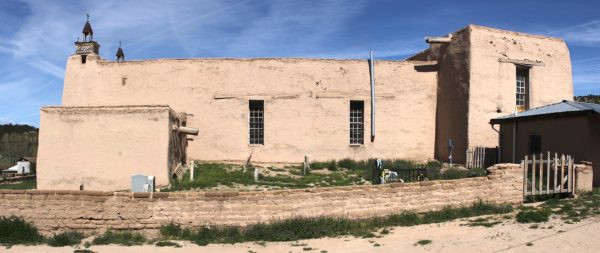
East side of the church. The mission and its walls have to be replastered
every year or two because of weather damage to their exterior mud surfaces.
And tomorrow was the first Sunday of May.
I awoke early on Sunday morning to go watch sunrise off of the Rio Grande Gorge Bridge, and then after breakfast, I had planned to retrace my route back to Las Trampas, and try my luck at finding the church open.
Following my arrival at the solitary and locked church around 10:15, a second car pulled into the parking lot and two other tourists left it to inspect the church. A third car arrived with two more people. And then a fourth, with three visitors. One of them began to talk about the church to his companions near me, and in a break of speech, I asked him if he knew if the church was holding services that day. He didn’t think so. He had never seen it open except for special services, even though he had lived in the area for nearly a decade. He returned to talking about the church with his companions in the lot before the steps to the yard entry arch, pointing out significant architectural features, when a fifth car enter the lot behind us.
A middle-aged woman and an older woman got out of the car, and a key dangled from a key chain in the woman’s hand as she walked through our little crowd and climbed the steps and walked into the church yard towards the doors of the church.
I and the lecturer exchanged a jovial glance, and then followed the women up the stairs into the yard.
“Are you opening the church?”
“Yes- we have Mass in a little while.”
“May we come inside and take a look around?”
“Yes- just please stay off of the altar, and no photography please.”
I was privately ecstatic.
The chapel was adequately lit by light entering the building through two broad windows on the east wall of the nave, and through single high windows on the two far transept walls. The white plastered walls within helped distribute the diffused sunlight. Two wood burning stoves were warming the chapel interior. A chandelier X dangling from a rope in the center of the nave held eight candles on each crossbar. The chapel floor was covered with old wooden boards. The twelve station images and five reredoses (panels) about the nave feature original colonial paintings that date back to the founding of the church in the late 18th century.
I stay in the cool sanctuary for twenty minutes, enjoying the quiet while I take in the vaulted ceiling defined by thick vigas, the slightly elevated wooden altar with its mix of colonial images on the screen, the table of the the late morning light lazing on the white plaster walls, the elevated pulpit on the east wall that is accessed by the wooden ladder leaning by it, artistic scrawls burned into the loft floor beams, the old planked floors, the simple choir balcony above the structure’s main entrance.
This is a 243 year old church.
Satisfied with my visit inside, I thank the mayordomo with the key and head back outside to take one more walk around the courtyard.
As I walk, I come upon Leroy, an elderly man with a vibrant voice and a warmth who asks me how I am doing. He is heading into the church as a volunteer to help the priest coming from Chimayo prepare for the service, but he stops to talk with me about the place.
He tells me there used to be a convent there at one time also, across the road, that held all of the old and important documents related to the church. It burned years ago, with the official church documents. A painful loss. He tells me confession used to be done in the sacristy off the left transept in the sanctuary. There was a cell for the priest to hear admissions. But that was years ago. They don’t do that any more. Today, people just talk face to face, he tells me.
He also tells me that behind the altar screen featured in the church is… a second altar screen- the original. There is a three feet gap between the two.
In more recent years (the last century), the church had two bells, but then one bell was stolen. The second was put in a mount on the ground for a long time after, until it was finally put back up in the tower, to call local worshipers to Mass.
I learn there are three priests buried under the altar, and that the church yard has been the cemetery for the village for over 200 years. There are 64 bodies buried under the wooden planks. Before the planks were there, the sanctuary floor was packed dirt. There were no windows put on the mission’s west side to try and help protect the building’s occupants from Indian attacks.
We hit a break in our conversation, and Leroy realizes he needs to get on with his duties, so he wishes me a fine day and makes his way toward the church.
I feel the warmth of the late morning sun on my neck and enjoy the building’s tan profile against the blue sky one more time, and then as another car enters the parking lot in the square, I go down to my truck, enter it, and head out toward Picuris Pueblo.

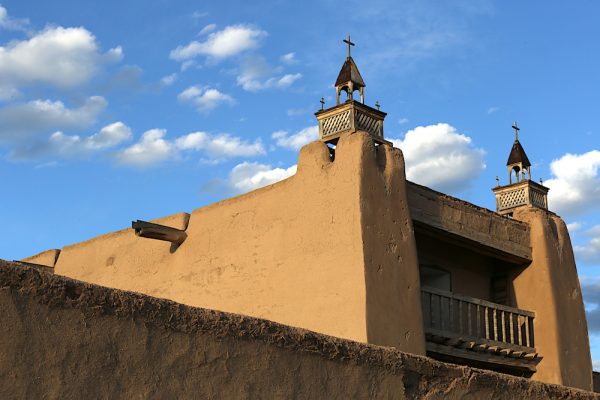
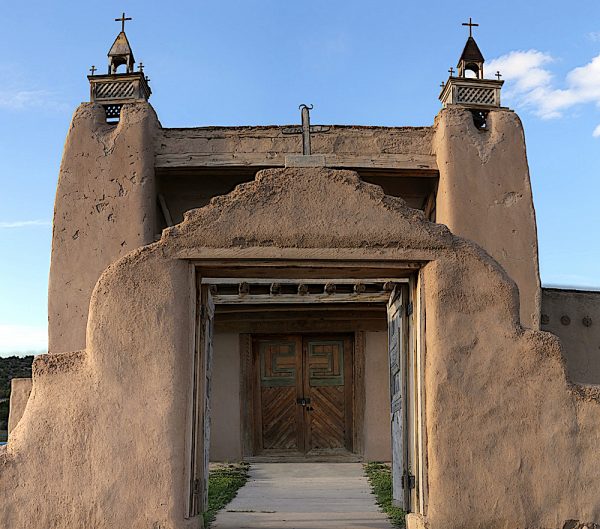
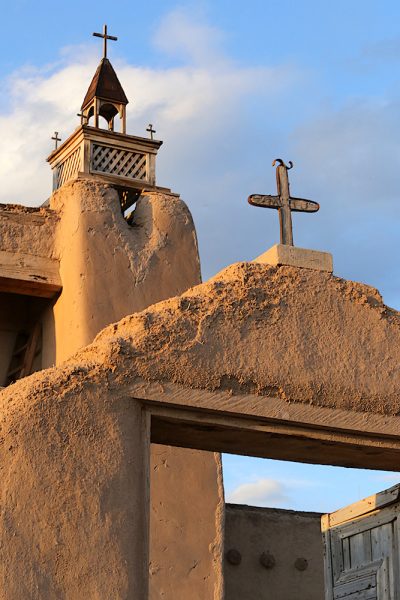
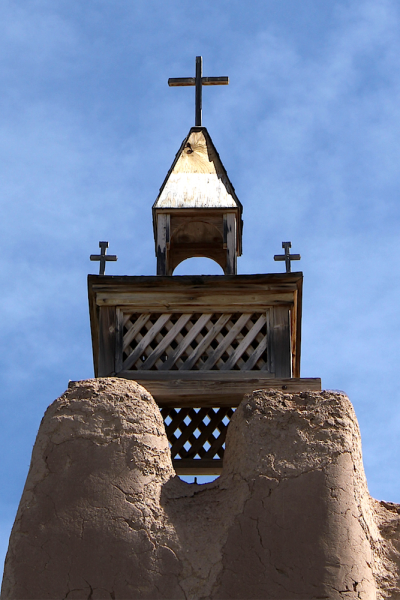
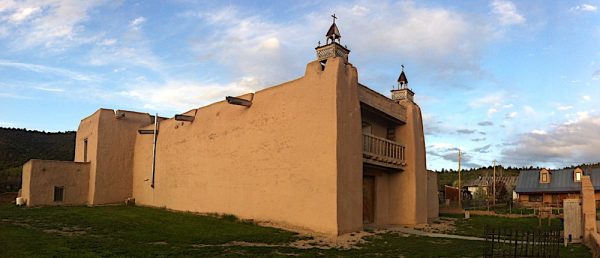
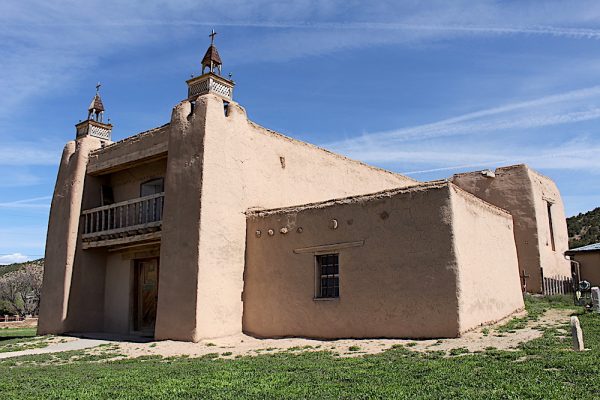
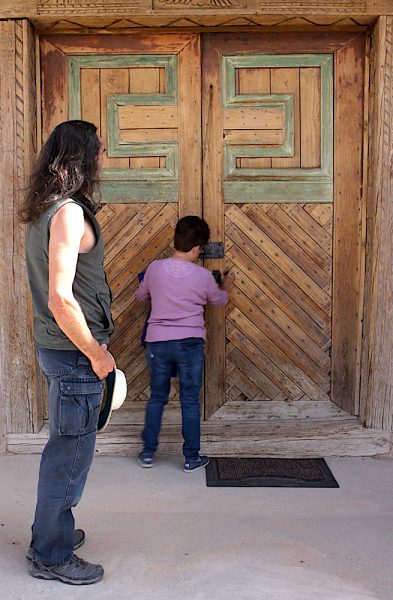
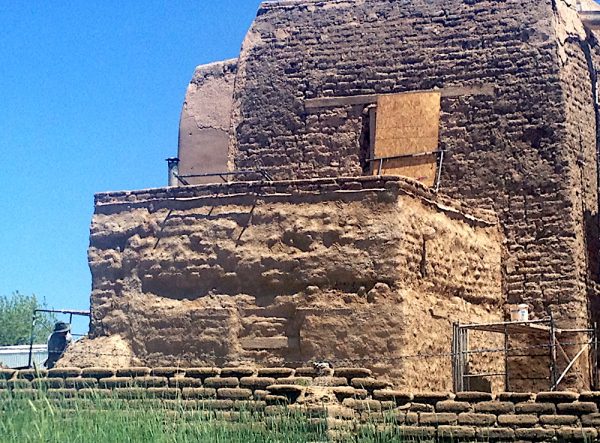
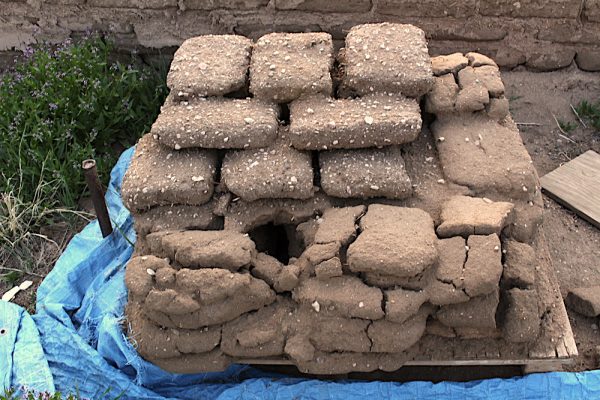

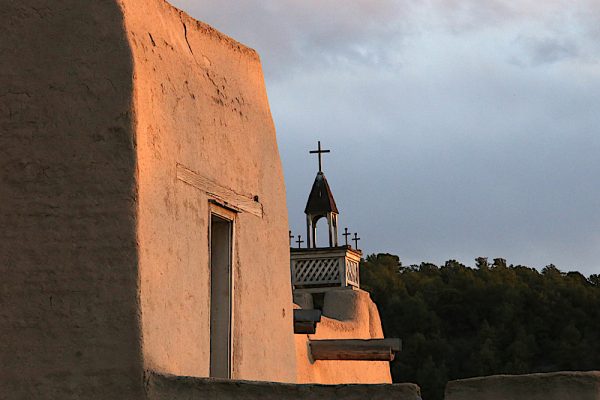
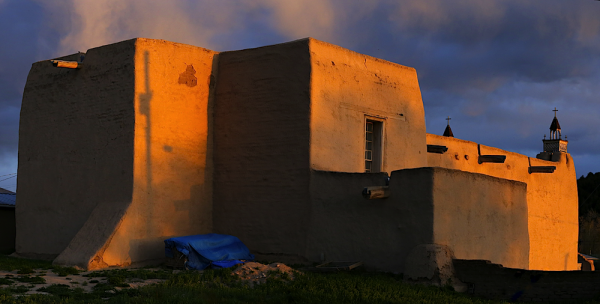
2 Responses to Day Trip Detour: San Jose de Gracia de Las Trampas